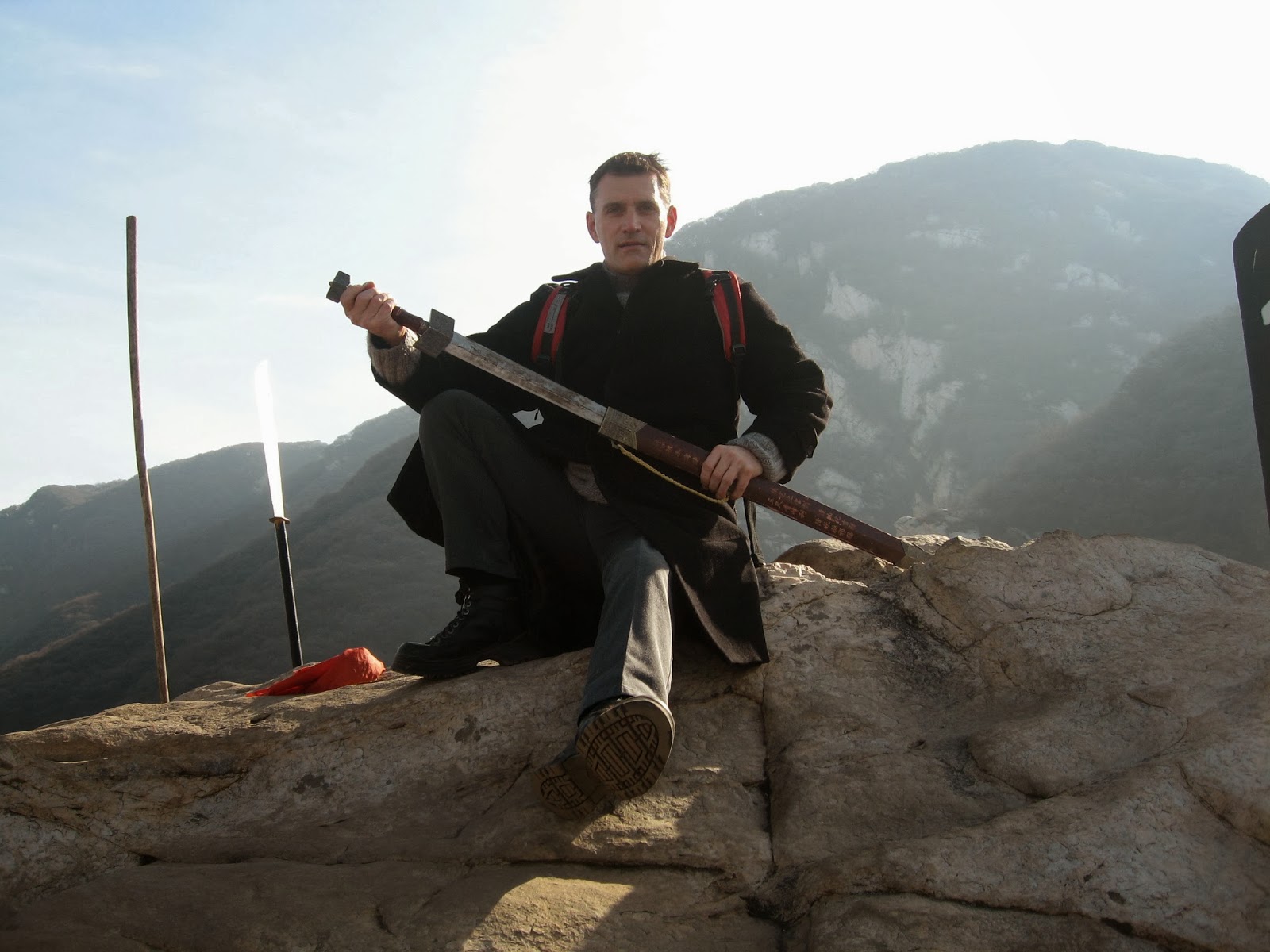Day 8
– Sun. Jan. 5: Although the weather was pleasant when we left Luoyang early in
the morning, it was much cooler when we arrived at the Shaolin Temple on Song
Shan Mountain approximately 50 miles to the west. Known as the Mid-sacred
Mountain in China, Mount Songshan was considered the center of Heaven and Earth
in ancient times and the origin of Chinese civilization.
Entrance to Mount Songshan and the Shaolin Temple
Entrance to Mount Songshan and the Shaolin Temple
The Shaolin Temple, founded in the 5th century AD, is known as the birthplace of Chan (Zen) Buddhism and Kung Fu, the origin of all the great Chinese martial arts. It was the earliest center for disseminating Buddhism in ancient times. Earlier in my life, I spent a great deal of time in Zen meditation. Having taken Buddhist precepts and been given a Buddhist name, the many visits I made to Buddhist sites on this trip were especially meaningful to me. Many years ago, I also received a black belt in Shim Gum Do (Mind-Sword Path), a Korean one-handed sword-style martial art. For many reasons, I felt a very special connection to this holy place and the history it represents.
Shaolin Temple
Burning incense at the Shaolin Temple
Shaolin Temple
Not far
from the temple is the Forest of Pagodas, an assembly of 214 brick stupas
commemorating renowned Shaolin monks that span seven dynasties.
Pagoda Forest
Pagoda Forest
We took a cable
car lift to the top of the mountain range where we had several interesting
encounters. At a small temple on the mountain top, a monk wrote my
name into a poem on a scenic print that he framed. After taking our photos at the top
of the mountain, we headed back down.
Cable car lift
My name in poetry
At the top of Songshan Mountain
There was much more to see and do (for
example, we missed the Kung Fu show and could have taken another cable car up
to the Dharma Cave, where Bodhidarma reportedly sat in meditation for nine
years), and it was difficult to pull ourselves away from the quietly peaceful
environment. I really wanted to just sit in meditation on the mountain all day, but we had to move on to our next stop.
Located
12 km south of Luoyang along the banks of the Yi River are the Longmen Grottoes.
This outstanding collection of Buddhist statuary was started around 493 when
Emperor Xiaowen of the Northern Wei Dynasty (386-534) moved the capital from
Datong to Luoyang. The grottoes were continuously added to over the next 400
years during the Sui Tang Dynasties. The whole complex spans about 1 km and boasts
1352 caves, more than 100,000 statues, 40 pagodas, and 3,600 inscribed tablets.
These works represent the high point of Chinese stone carving; however, vandalism,
theft, and neglect have tragically scarred the site.
Caves of the West Hill
West Bank Fengxian Cave viewed from the East Bank
Fengxian Si Cave
The site comprises 4 sites, which we visited in order: Caves of the West Hill, Caves of the East Hill, Xiangshan Temple, and Bai Juyi’s Tomb. The largest and most iconic of the caves is Fengxian Si (Ancestor Worshipping Cave), which lies on the west bank and dates to 675. It contains the impressive 17-meter tall seated Vairocana Buddha flanked by bodhisattvas and heavenly guardians. The smiling, feminine face of the Buddha has earned it the nickname the “Eastern Mona Lisa.” The enormity and impressiveness of the entire site defy description and must be experienced to be truly appreciated.
Lianhua (Lotus) Cave
Wan-fo (Thousand Buddha) Cave
Fengxian Si Cave - Vairocana Buddha
Fengxian Si Cave - Heavenly King & Guardian
Fengxian Si Cave - Vairocana Buddha
Xiangshan
(Fragrant Hill) Temple lies on the east bank. It was originally built during
the North Wei Dynasty (516) and later rebuilt during the Tang and Qing
Dynasties. In 1936, it served as the summer palace of the President of the
Republic of China, Chiang Kai-shek, and his wife Song Mei-ling.
It was another thoroughly rewarding and enjoyable day.
It was another thoroughly rewarding and enjoyable day.
Xiangshan Temple
Xiangshan Temple
Xiangshan Temple
Xiangshan Temple
Click on the following links for more information about




















No comments:
Post a Comment